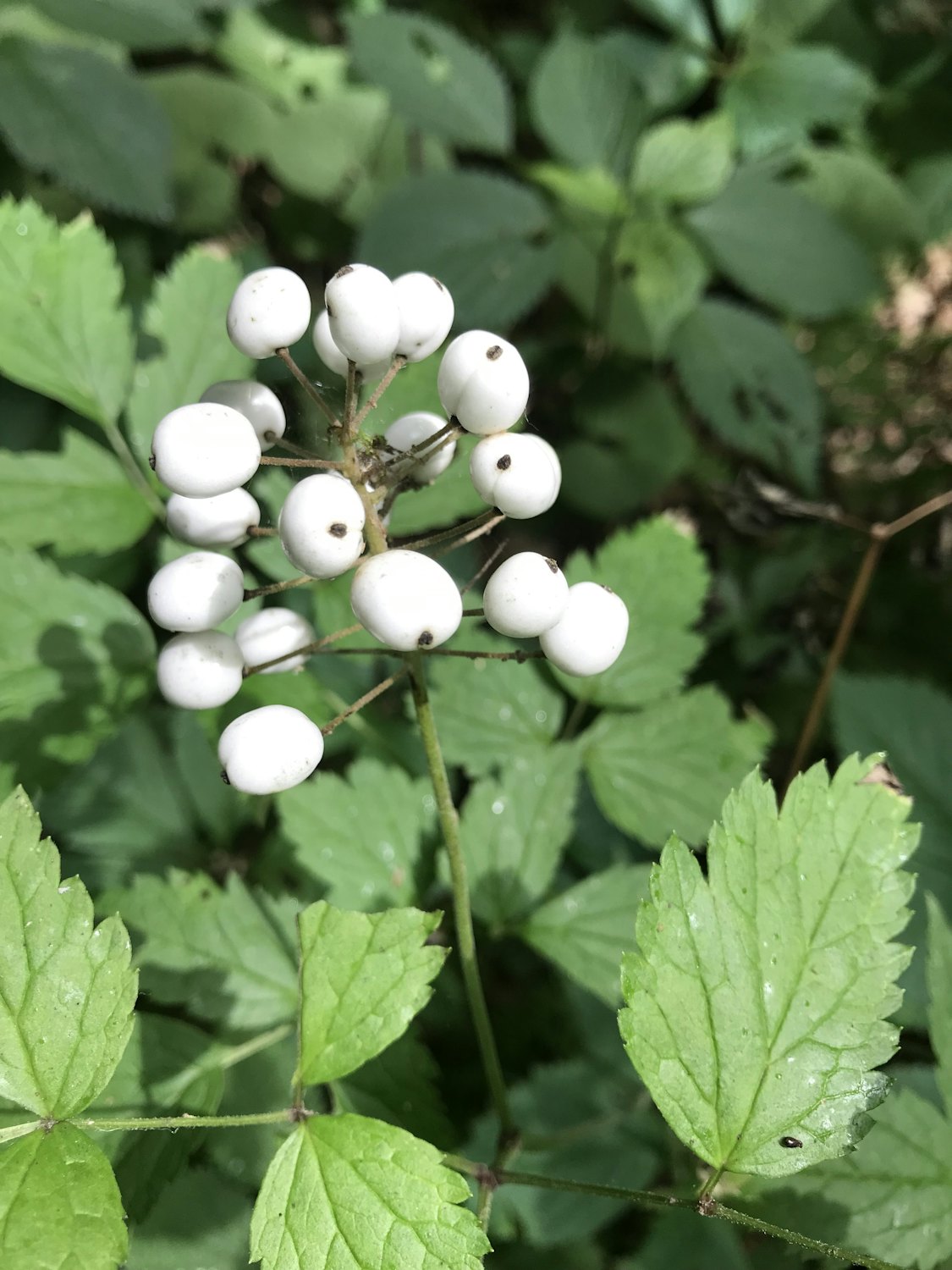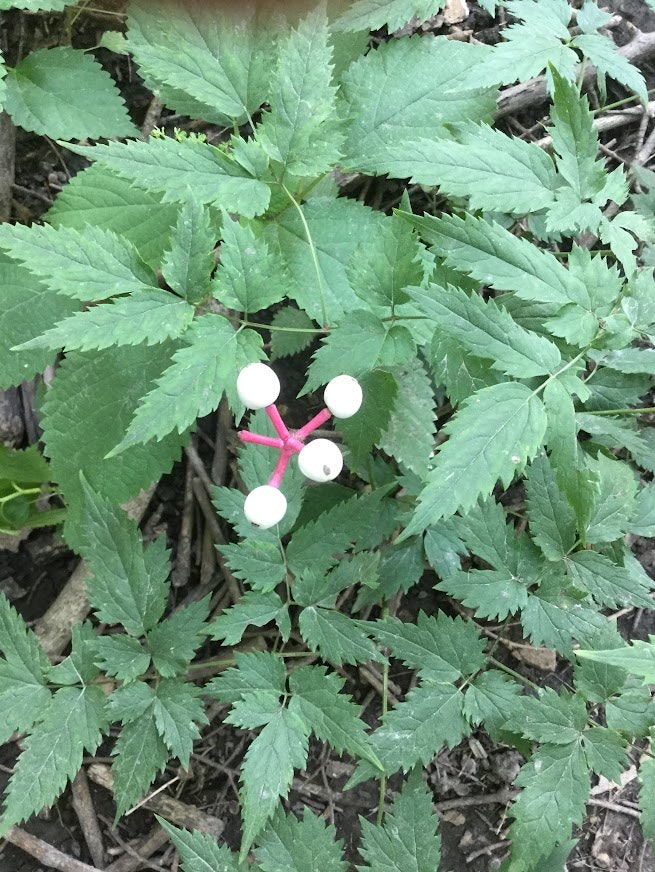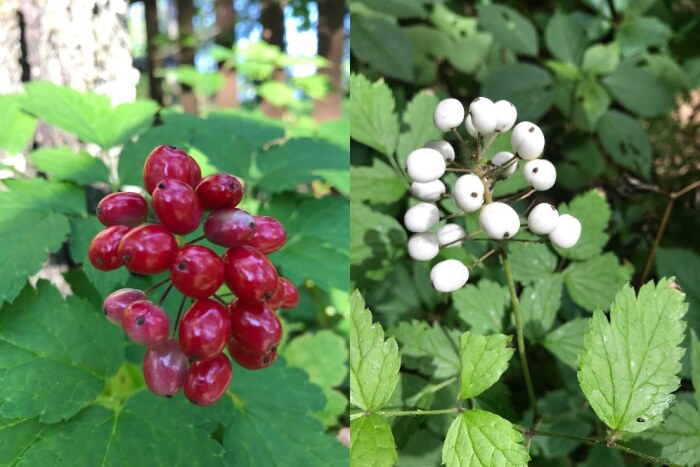Luther College Associate Professor Beth Lynch took all the photos featured in her latest essay.
This post is about two closely related plant species that can be confusing for the novice to identify. Both of them grow in the forests of Iowa, though red baneberry (Actaea rubra) is far more common.
Red baneberry is one of those forest wildflowers that is never abundant, but I can pretty well count on finding it when I walk through shady hardwood forests of Iowa. The plants are about 1 to 2 1/2 feet tall and have compound leaves that are divided into 3 to 5 leaflets; each leaflet is then divided again into more leaflets that have coarse teeth along the margins and are pointed at the tip.
In early summer the plant produces a single fluffy cluster of small white flowers at the top of a long stalk. Red baneberry plants are not particularly showy until mid- to late-summer, when the fruits turn from pale green, to pink, to deep red. Plants produce a cluster of shiny berries, each one about one-third of an inch in diameter and with a small black dot marking the remains of the style.


As with many other members of the buttercup family (Ranunculaceae), the berries and other parts of the plant are toxic to humans. Several indigenous groups in North America use the plants for medicinal purposes. I suspect that the plants may be toxic, or at least nasty tasting, to white tailed deer, since I never see evidence of deer browsing them, despite extremely high deer populations in northeastern Iowa woodlands.
Many species of birds such as robins, catbirds, and brown thrashers eat the berries, passing the seeds intact. Presumably birds are effective at dispersing the seeds to new habitats. Small mammals may also consume the fruits, but they tend to destroy the seeds, so they may be less helpful seed dispersal agents—unless they bury the seeds and forget about them. I’ve noticed that the chipmunks in my woods tend to do this, and I find clumps of gooseberry, multiflora rose, and prickly ash seedlings growing from forgotten chipmunk caches.
It is not uncommon to find a red baneberry plant that produces snow-white berries when ripe, instead of the usual deep red.

Often these plants are mixed in with red-fruited plants, as in the photo below.

No one knows why red baneberry exhibits dimorphic fruits (fruits with two different colors). Plants with fleshy, edible fruits produce fruits primarily for the purpose of attracting seed dispersal agents, in this case birds. Biologists think brightly colored fruits evolved to better attract animals to the plants when the fruits are ripe. But it remains an ecological mystery why most red baneberry plants produce red berries, while individuals produce white berries. Biologists don’t even know if plants differ in how successful they are at reproducing, or if the frequency of white-berry-producing plants differs among habitats or geographic areas.
To make matters even more confusing, there is a sister species to red baneberry that also grows in Iowa, white baneberry (Actaea pachypoda). Its fruits are…well, white, although sometimes they may be pink (as in the photos below) or red (something I have never seen). The leaves and flowers of the plant look nearly identical.
White baneberry is much less common than red baneberry in Iowa, occurring only in the eastern portion of the state and preferring forests with very rich organic soils. While I find lots of red baneberry (with red or white fruits), I can remember only one population of white baneberry in Winneshiek County; it’s in an ancient sugar maple-basswood-red oak forest on deep rich soils.


It would be very easy to confuse a white-fruited plant of red baneberry (Actaea rubra) with white baneberry (Actaea pachypoda). However, one important difference between the two species can be used to tell them apart. Red baneberry has slender stalks on the flowers and fruits. The flower/fruit stalks on white baneberry are much thicker, turning bright pink when the fruits ripen.
The black dot (the old flower style) on the white baneberry fruit is also larger. In fact, another common name for this species is doll’s eyes, because of the creepy resemblance of the berry to the lifeless stare of a doll’s eye. When I was a kid, I used to imagine people sewing the berries onto the faces of handmade cloth dolls.

The next time you happen to spot baneberry plants, look carefully to see which species you have: red baneberry (Actaea rubra) or white baneberry (Actaea pachypoda). And perhaps you too can wonder why some red baneberry plants produce white berries while others have red berries.
Additional information:
Minnesota Wildflowers provides excellent guides to the red and white baneberry species. When you visit their pages, please consider giving a donation to help cover the costs of making and maintaining the website.
Willson, M. F. 1983. Natural history of Actaea rubra: fruit dimorphism and fruit/seed predation. Bulletin of the Torrey Botanical Club, 110(3), 298-303.


1 Comment
Thank you, Beth Lynch
These fruits are as lovely as any flower, and it’s so nice to see them here.
PrairieFan Sat 19 Aug 7:59 PM